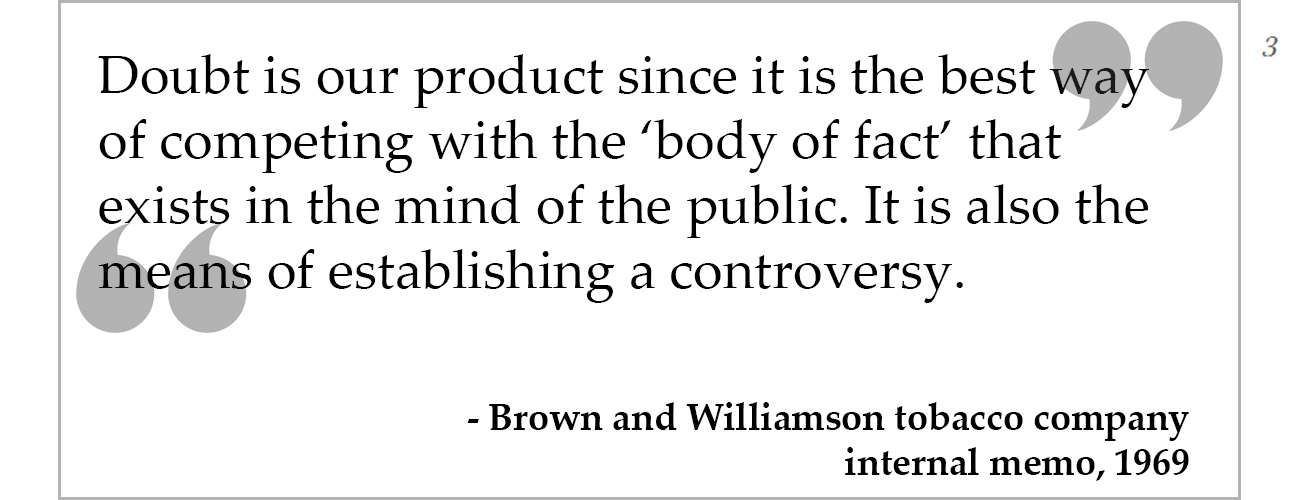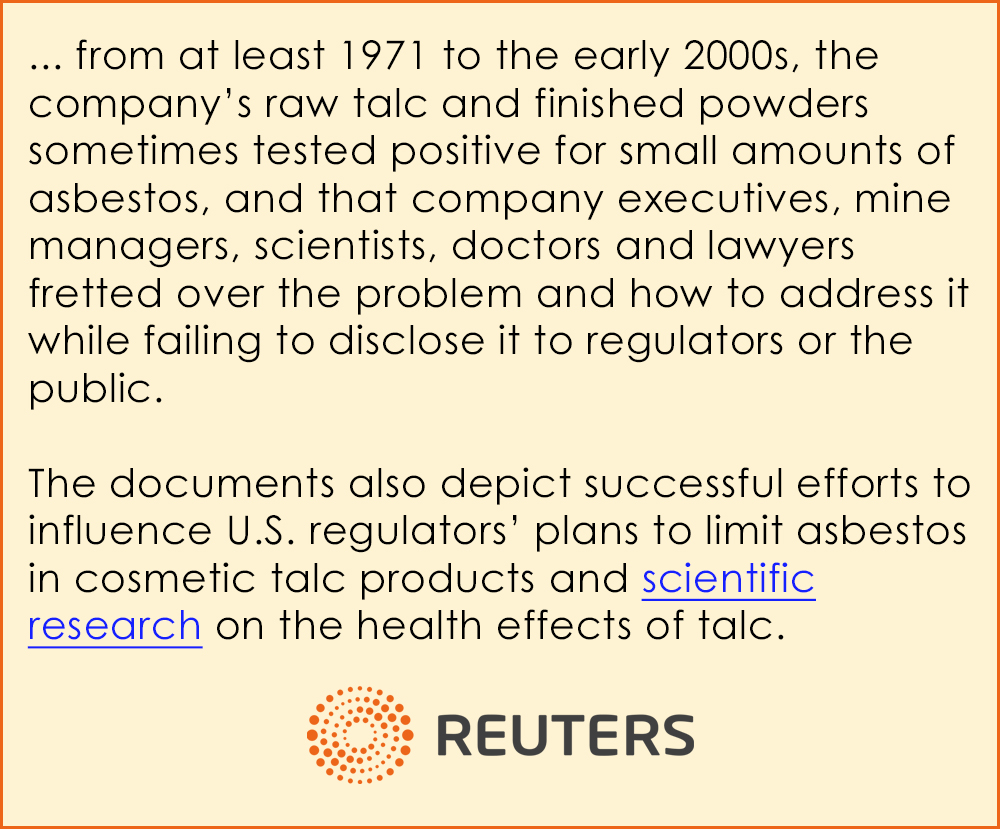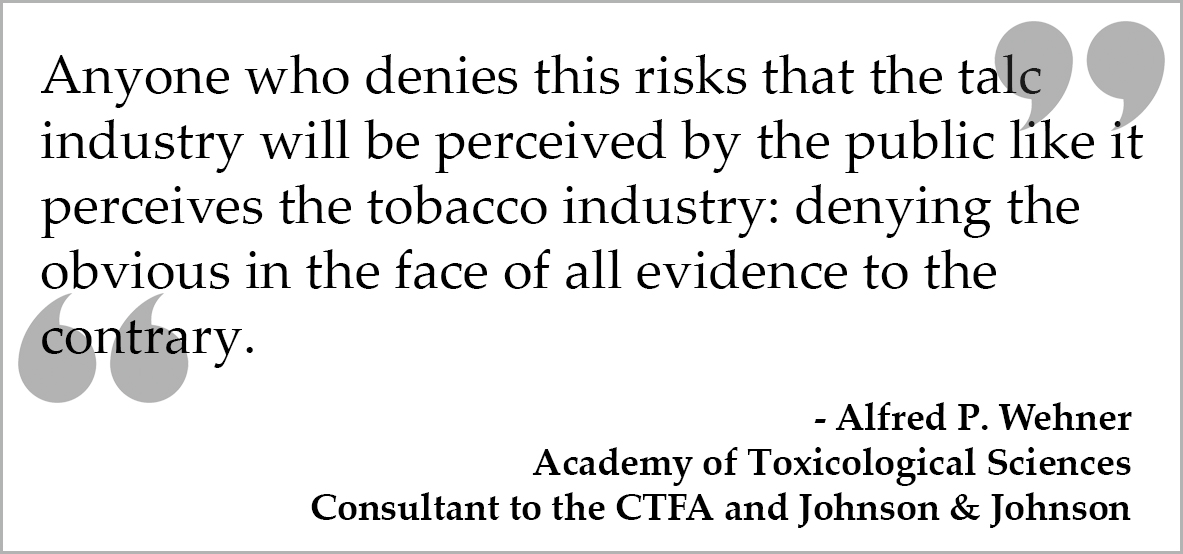Tobacco and Talc: Corporate Playbooks to Hide the Truth
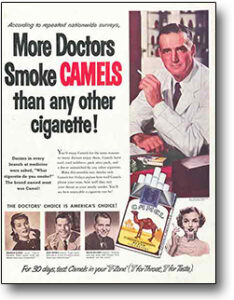 For decades, Big Tobacco publicly denied what it internally knew to be true. It ran deceptive campaigns, misled policymakers even when under oath and paid for biased research to help create confusion. The longer the truth was withheld, the more people smoked unaware of the damage it was causing to their bodies. Regulations were delayed that may have given people the information they needed and protected them from industry predation. 1
For decades, Big Tobacco publicly denied what it internally knew to be true. It ran deceptive campaigns, misled policymakers even when under oath and paid for biased research to help create confusion. The longer the truth was withheld, the more people smoked unaware of the damage it was causing to their bodies. Regulations were delayed that may have given people the information they needed and protected them from industry predation. 1
Scientific research linking tobacco use and cancer began to be published in the early 1950s. Companies such as RJ Reynolds responded by denying the evidence, and in 1954 issued a consumer-directed advertisement with statements that included:

Research suggests, however, that tobacco companies knew by the mid-1950s that their products were linked to cancer and were addictive. 2
Pushing back against this threat to their industry, tobacco companies took a stance to consistently and simply deny the mounting evidence and sought to create doubt and confusion around the research. An internal 1969 memo from a British American Tobacco subsidiary said it in plain language:
In 1994, CEOs of seven major tobacco companies testified under oath to the U.S. Congress. 4 Joseph Taddeo, then-President of U.S. Tobacco Company, told Congress:

The other six CEOs agreed.
Today, no reasonable person would deny the association of cigarette smoking to various forms of cancer. Few deny that smoking is addictive.
Corporate Misconduct: Talc is Today’s Tobacco
But the patterns of denial and doubt shown by the tobacco industry have a close parallel in the efforts by Johnson & Johnson to control the controversies surrounding the use of talc and the risk of ovarian cancer, as shown in the following table.
Checklist of Parallels Between Talc and Tobacco
| Tobacco | Talc | |
|---|---|---|
| Decades of knowledge of carcinogenic health risks of its products | X | X |
| Repeated denials of health risks | X | X |
| Efforts to influence federal, international regulatory bodies to deny the science | X | X |
| Hiring away regulatory officials to influence governmental oversight | X | X |
| Covertly funding studies to counter the science showing health risks | X | X |
| Destroying documents showing corporate accountability | X | X |
| Using a trade association to hide individual corporate influence of regulators | X | X |
| Giving misleading, false statements before congressional committees | X | X |
| Threatening researchers, former employees and others willing to expose the truth | X | X |
| Targeting minority communities as product sales decline in other demographics | X | X |
A timeline of major events in the talc controversy shows Johnson & Johnson has been aware of the potential carcinogenic dangers of its talcum powder products for decades. However, in the face of mounting scientific research and regulatory efforts, the company has repeatedly affirmed that in the company’s view, its talcum powder products were perfectly safe.
However, as outlined in at 2018 Reuters investigation:
Those successful efforts to influence and turn aside multiple attempts for increased scrutiny and regulation of talcum powder products were managed primarily through the Cosmetic, Toiletry and Fragrance Association (CTRA). Now known as the Personal Care Products Council, a 2021 study found that the lobbying organizations and
…particularly J&J (which held the majority of the talc powder market share), exerted considerable influence over:
- Regulatory proceedings at the FDA;
- Testing methods and the manipulation of test results (including undisclosed results); and
- Press coverage and the medical literature. 5
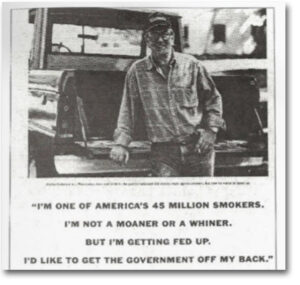 This effort closely follows the playbook established by RJ Reynolds in creating the “Get Government Off Our Back” coalition in 1994 to fight federal regulation of tobacco. By keeping its involvement secret, RJ Reynolds was able to draw public and legislative support and to avoid the tobacco industry’s reputation for misrepresenting evidence. The tobacco industry has a history of misrepresenting scientific evidence, attempting to directly influence government through the use of lobbying and campaign contributions. 6
This effort closely follows the playbook established by RJ Reynolds in creating the “Get Government Off Our Back” coalition in 1994 to fight federal regulation of tobacco. By keeping its involvement secret, RJ Reynolds was able to draw public and legislative support and to avoid the tobacco industry’s reputation for misrepresenting evidence. The tobacco industry has a history of misrepresenting scientific evidence, attempting to directly influence government through the use of lobbying and campaign contributions. 6
However, while pushing a false narrative about the safety of talc the CTRA was not immune from internal dissent that evoked the similarities between the tobacco and talc industry game plans. A 1997 letter from a renowned toxicologist to a Johnson & Johnson colleague pointed out the downside of such tactics. Criticizing the CTRA for statements denying the talc-ovarian cancer association, the letter says, in part:
The overwhelming number of credible studies published in peer-reviewed medical literature in the past two decades continue to show statistically significant associations between genital talc use and ovarian cancer.
The National Cancer Institute, the International Agency for Research on Cancer, and Health Canada are just a few of the respected organizations that have identified the carcinogenic properties of talc.
In 2020, Johnson & Johnson announced the company would halt manufacturing and sales of talcum powder products in North America, followed by an announcement that it would cease producing all talc-based products globally by 2023.
Beginning in 2021 the company launched two unsuccessful attempts to settle all talc litigation through the bankruptcy courts. Although rejected, J&J has indicated the possibility of a third bankruptcy attempt. Those efforts at bankruptcy halted virtually all associated trials and stymied serious efforts at a fair settlement for ovarian cancer victims. Those repeated efforts to manipulate the federal bankruptcy system have drawn criticism from the judiciary and legal scholars and have drawn the ire of elected officials.
Sen. Josh Hawley Grills Johnson & Johnson Lawyer Erik Haas in Senate Judiciary Committee Hearing
Total tobacco sales have declined across U.S. multi-outlet, food, and convenience channels every quarter since Q1 2022. But other tobacco products, including smokeless tobacco and alternatives, cigars, loose tobacco, papers, and vaping products, increased sales in Q2 2023.
Johnson & Johnson continues to claim its talcum powder products were safe and asbestos free. Doubt is its product now.
The parallels between the historical postures of Big Tobacco and the Talc Industry in defending their products are too many to mention. The judicial opinion below, delivered during the tobacco litigation, could apply equally to both:

